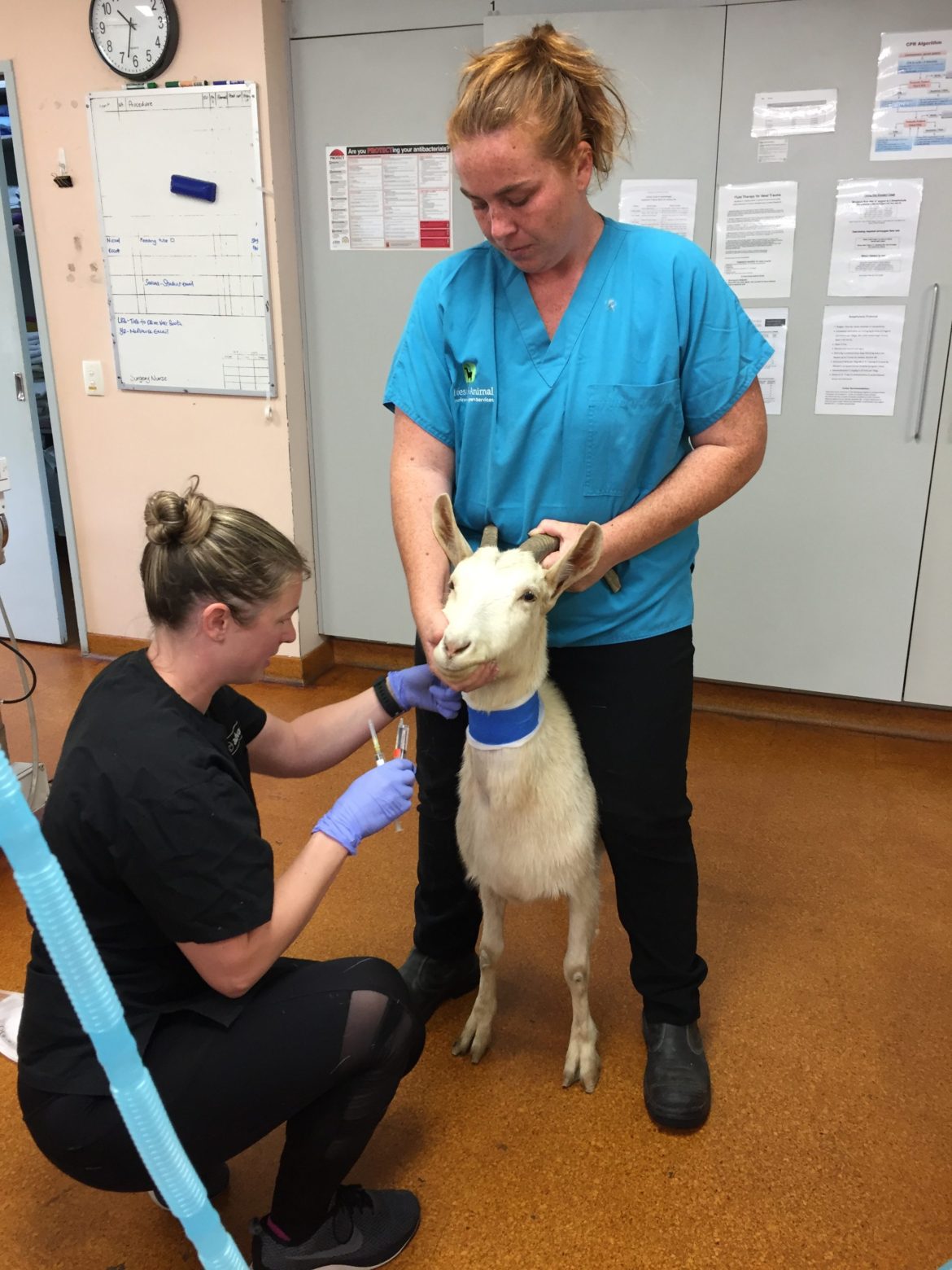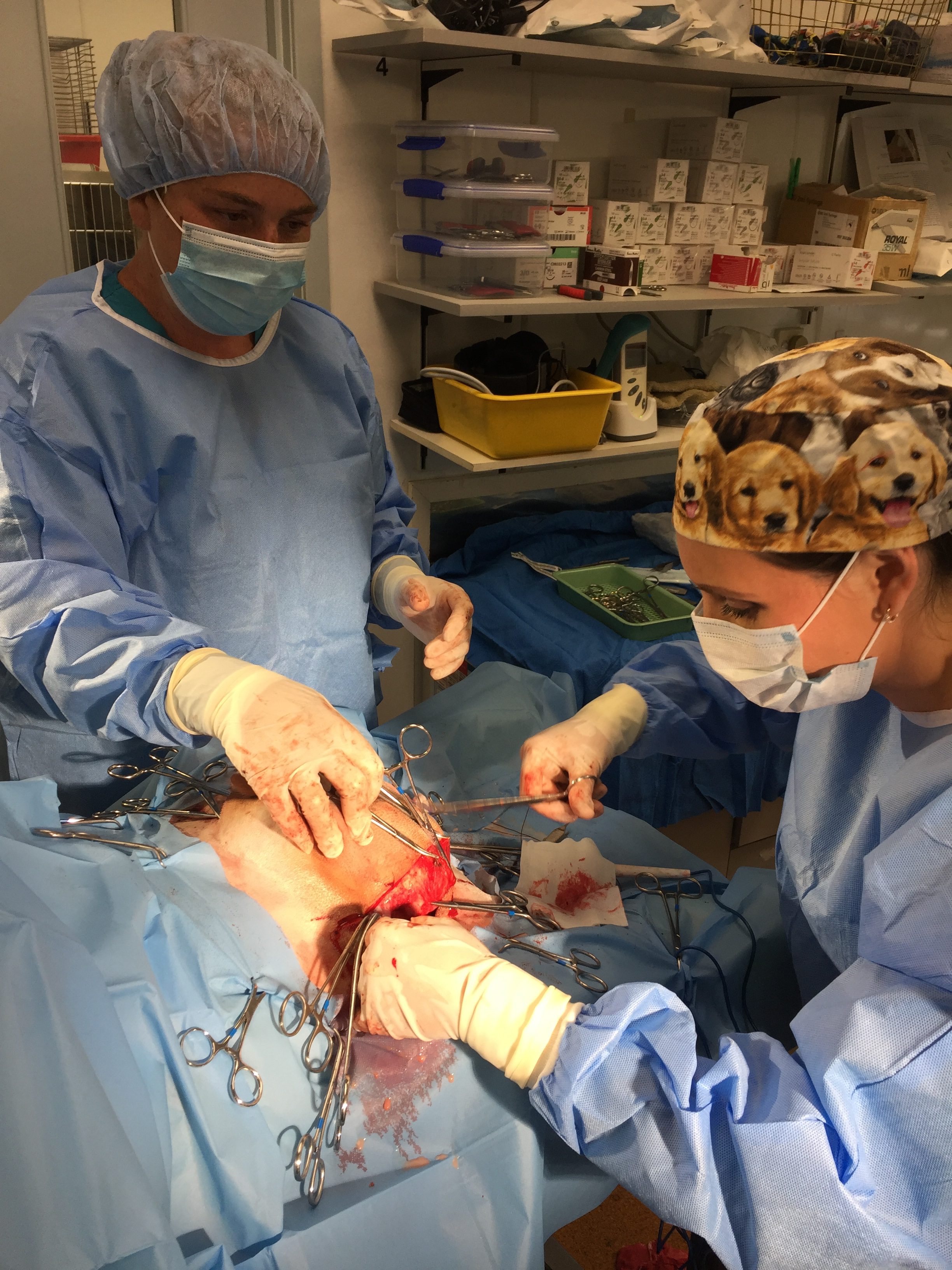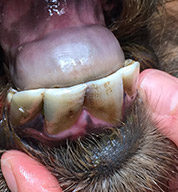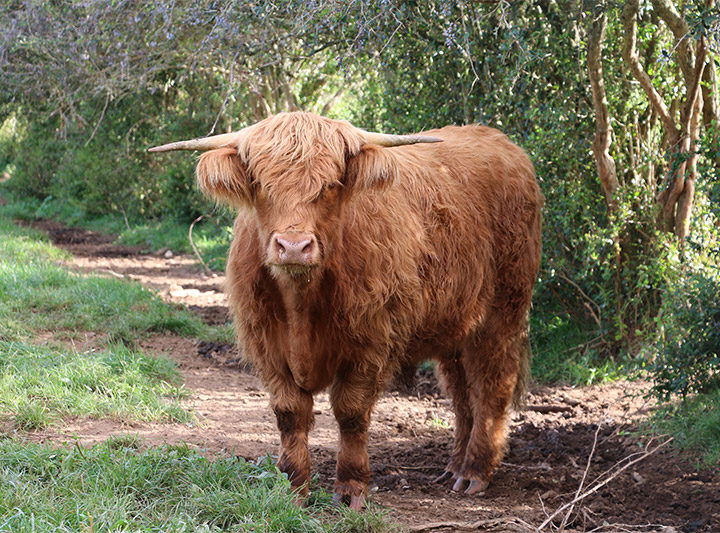
Brulee and her Lifesaving Mastectomy Surgery
Brulee is a gorgeous young goat that now only had an enlarged udder, but she also had numerous rather large strange lumps present in both of her mammary glands.

Lisa and Alice are preparing Brulee for surgery. She is about to be anaesthetised
What caused Brûlées sudden udder enlargement?
When we examined Brûlée her udder was hugely distended, and she complained heavily when her udder was palpated. Her udder was full of milk. Brûlée’s had a hormonal condition called pseudo pregnancy- or false pregnancy. This disease process occurs when the normal reproductive cycle is interrupted by the persistent presence of a corpus luteum on the ovary. A corpus luteum should only be present on the ovary for a few days during the normal reproductive cycle, however, when this structure refuses to regress, we end up with something called a persistent corpus luteum (CL). The problem with this is that this CL pumps out progesterone, making the goat think it is pregnant. This progesterone causes the goat’s udder to start increasing in size in preparation for the “false pregnancy” that doesn’t exist.
In addition to her pseudopregnancy and udder enlargement, Brulee also developed spontaneous lactation where she had started producing milk. Sometimes this is also termed Maiden milker syndrome. This condition appears to be more common in Saanen goat breeds, and in some herds up to 30% of the animals may be affected.
The good news is that treating pseudopregnancy is fairy straight forward. Two hormonal injection of prostaglandin 10-12 days apart is usually enough to cause the persistent CL to regress, and the normal reproductive cycle continues. The bad news is that once the udder has started producing milk, it can be difficult to get it to stop. We usually need to put the animal on a declining plane of nutrition (Jenny Craig diet) so that the body can tell the animal to STOP producing milk because there is not enough food available to facilitate milk production.
Why do we need to treat pseudopregnancy and why is spontaneous lactation less than ideal?
Untreated goats are at risk of the following:
– Excess progesterone production can cause the uterus to fill up with fluid (hydrometra)
– Excess progesterone production can cause immunosuppression, resulting in pyometra (infection of the uterus which can be life threatening)
– Excess progesterone can increase the risk of cancer due to bone marrow suppression etc.
Why do we need to stop lactation?
If your goat has been diagnosed with maiden milker syndrome and you want to start milking your goat every single day then that is great! If however you are not planning on milking your goat then we need to stop lactation for the following reasons:
– The sudden increase in milk production resulting in an enlarged udder can be painful for the goat
– Sudden milk production may cause milk to leak out of the teat, which may enable bacteria to crawl up the teat resulting in mastitis
More about Brûlée:
Brûlée had been diagnosed with pseudopregnancy and inappropriate lactation syndrome, and we used progesterone blood testing to diagnose this definitively. She received two injections of prostaglandin 10 days apart and was put on a reducing nutritional plane. Brûlée was also put on an aggressive course of antibiotics as we had also diagnosed her with mastitis.
Despite this, Brûlée was in a lot of pain. Her udder was swollen, milk was leaking out of her teats, and the large masses were getting larger and larger. Even a 14 day course of heavy duty antibiotic and pain relief therapy was not able to treat her mastitis. Brûlée was getting thinner every week. She was not responding to medical therapy and her udder was causing her so much grief that she didn’t even want to walk down to her owner for treats.
How did we help cure little Brulee in time for Christmas?
Brulee had been through one hell of a month. She developed spontaneous maiden milker syndrome and huge distended udder was causing her a lot of pain. On top of all of that she had also developed serious Staph Aureus mastitis infection, which was causing her to feel ill, loose weight and her mental heath was waning. A medical treatment approach using anti-inflammatories, aggressive intra-mammary AND injectable antibiotics had been unsuccessful. We had no other option that to take a surgical approach.
Her incredible owners that love Brulee so clearly agreed that it was time for us to perform a mastectomy surgery to remove this heavily infected and painful udder once and for all.
The Lifestyle Vet Team, which consisted of veterinary surgeon Laura, veterinary nurse Alice and veterinary technician ruminant and anaesthetist Lisa performed a mastectomy surgery on Brulee. After a very long surgery, her troublesome udder was gone!
Mastectomies are not for the faint hearted. Why is this?
– There are 6 VERY large veins and 4 VERY large arteries that supply the udder. The arteries need to be tied off BEFORE the veins are tied off to ensure that a considerable amount of the patients blood supply is not stuck inside the udder when the udder is removed.
– Accidental laceration of any of these vessels during surgery, or forgetting to ligate the arteries first may result in excessive blood loss, where the patient may need an emergency blood transfusion. For this reason a blood donor/friend goat should always be on standby just in case.
– Care must be taken not to accidentally cut into the mammary tissue that contains milk. Milk acts as a foreign body and it should not come into contact with any other tissues.
– Goat anaesthesia’s are tricky. Goats are prone to regurgitating during surgery and careful monitoring my an experienced small ruminant anaesthetist is recommended. We are so lucky to have the incredible Lisa on our team, who is very experienced in small ruminant anaesthesia.
– Care must be taken to reduce ALL dead space when closing up after the mammary gland has been removed. This means that no pocket of tissue should be remain unclosed. Any open areas WILL fill with fluid, resulting in seroma formation and possible secondary infection. Brulee’s wound was meticulously closed and a drain was inserted as a precaution to facilitate drainage of any fluid that may have accumulated.
Brulee was hospitalised with The Lifestyle Vet Team for a few days to ensure she was healing well. She received morphine, fluids and anti-inflammatories to reduce any pain that may have been associated with surgery.

We are happy to report that Brulee is doing exceptionally well after her major surgery 🙂
Has your goat been suffering from severe chronic mastitis? We can help. Contact us today on 027 VET LIFE (0278385433) or email us at laura@thelifestylevet.co.nz




